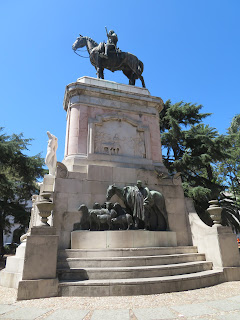Day 44 Mon. 2/27 Montevideo, Uruguay 8-6:00
Montevideo is the capital and largest city in Uruguay. About 1/3 of Uruguay’s population lives in Montevideo. It is the hub of commerce and higher education in Uruguay and its chief port. The city is also the financial hub of Uruguay and the cultural anchor of a metropolitan area. Throughout history, Montevideo has had some turmoil politically and financially. In 2017, the city had maintained 15 years of economic growth. Other information I read said it was very dangerous. We walked to the downtown and looked around. There are many beautiful old buildings and also many empty buildings. It did not look like an overly prosperous area.
It is dedicated to the Immaculate Conception and the patron saints of Montevideo, Philip and James.
Looks like the sun on Uruguay's flag
Salvo Palace was designed by Mario Palanti and was completed in 1928. Currently, there is a tango museum inside. Originally, the building was planned to be a hotel, but that didn’t work out. Private offices and residences have been and continue occupy the building.
In this picture you can see some of the 33 palm trees on the plaza that are a homage to the 33 men led by Juan Antonio Lavalleja y de la Torre (who would later become president of Uruguay) into battle during the Independence War.
Gateway of the Citadel is one of the few remaining parts of the wall that surrounded the oldest part of the city.
Solis Theater is a neoclassical performance hall and Uruguay's most renowned theater. It dates back to 1856, and was built using European marble and timber and designed by an Italian architect. Over the decades, Teatro Solis has become the heart of Montevideo's performing arts scene, and stars from all over the world have stepped on its stage – from dancer Isadora Duncan to actress Sarah Bernhardt.Today, Teatro Solis is the official home to the State Theater Company and the Montevideo Philharmonic Orchestra, and visitors can attend concerts, operas, classical music, and plays by both local and international artists.
Plaza Independencia is the most important square. It was laid out in the 19th century in the area once occupied by the Citadel of Montevideo. The center monument is General Jose Gervasio Artigas. His mausoleum is below the statue. The Executive Tower (on the left in back of the statue) is the official work place of the President of Uruguay.















No comments:
Post a Comment